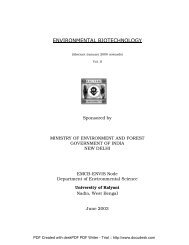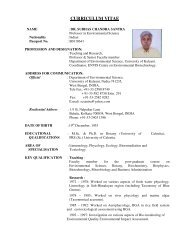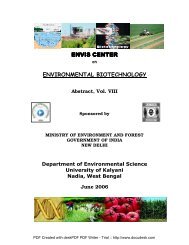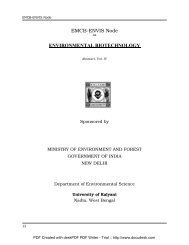EMCB-ENVIS Node ENVIRONMENTAL BIOTECHNOLOGY
EMCB-ENVIS Node ENVIRONMENTAL BIOTECHNOLOGY
EMCB-ENVIS Node ENVIRONMENTAL BIOTECHNOLOGY
Create successful ePaper yourself
Turn your PDF publications into a flip-book with our unique Google optimized e-Paper software.
<strong>EMCB</strong>-<strong>ENVIS</strong> Centre<br />
glyoxalase I, while GSH peroxidase Se-independent enzyme and GSH reductase showed no<br />
significant variation in activities. The increase in the enzymes activities of catfish, involved in<br />
the inactivation of reactive molecules formed during oxidative stress, could provide an additional<br />
protection against the oxidative damage induced by mercury.<br />
Aran Incharoensakdi, Pissopa Kitjaharn. (Laboratory of Biochemical Products, Department<br />
of Biochemistry, Faculty of Science, Chulalongkorn University, Bangkok 10330, Thailand).<br />
Zinc Biosorption from Aqueous Solution by a Halotolerant Cyanobacterium<br />
Aphanothece halophytica. Current Microbiology, 45(4) (2002), 261 – 264.<br />
We have investigated the characteristics of zinc biosorption by Aphanothece halophytica. Zinc<br />
could be rapidly taken up from aqueous solution by the cells with an equilibrium being reached<br />
within 15 min of incubation with 100 mg Lm1 ZnCl2. The adsorbed zinc was desorbed by<br />
treatment with 10 mM EDTA. The presence of glucose, carbonyl cyanide mchlorophenylhydrazone<br />
(CCCP), and N,N'-dicyclohexylcarbodiimide (DCCD) did not affect the<br />
uptake of zinc. The specific uptake of zinc increased at low cell concentration and decreased<br />
when cell concentration exceeded 0.2 g Lm1. The binding of zinc followed Langmuir isotherm<br />
kinetics with a maximum zinc binding capacity of 133 mg gm1 and an apparent zinc binding<br />
constant of 28 mg Lm1. The presence of an equimolar concentration of Mn2+, Mg2+, Co2+, K+,<br />
or Na+ had no effect on zinc biosorption, whereas Ca2+, Hg2+, and Pb2+ showed an inhibitory<br />
effect. The biosorption of zinc was low at a pH range from 4 to 6, but increased progressively at<br />
pH 6.5 and 7.<br />
B. Clasona, W. J. Langstonb, G. -P. Zauke. (Carl von Ossietzky Universität Oldenburg,<br />
Institut für Chemie und Biologie des Meeres (ICBM), Postfach 2503, D-26111, Oldenburg,<br />
Germany. Marine Biological Association, Citadel Hill, Plymouth PL1 2PB, UK).<br />
Bioaccumulation of trace metals in the amphipod Chaetogammarus marinus<br />
(Leach, 1815) from the Avon and Tamar estuaries (UK): comparison of twocompartment<br />
and hyperbolic toxicokinetic models. Water Research, 37(10) (2003),<br />
2505-2511.<br />
Bioaccumulation of Cd, Cr, Cu, Co, Pb, Ni and Zn was investigated in the eulittoral<br />
gammaridean amphipod Chaetogammarus marinus (Leach, 1815) from the Avon and Tamar<br />
estuaries (UK). The main goals were to provide information on accumulation strategies of the<br />
organisms tested and to verify toxicokinetic models as a predictive tool. The organisms<br />
accumulated metals upon exposure and it was possible to estimate significant model parameters<br />
of two-compartment and hyperbolic models, with the exception of Zn. Both types of models<br />
yielded significant model estimates in two independent toxicokinetic studies using gammarids<br />
from the Avon and Tamar estuaries, respectively. Kinetic BCFs at theoretical equilibrium were<br />
58–102 for Cd, 95–215 for Cr, 400–963 for Cu, 38–59 for Co, 150–750 for Pb and 33–63 for Ni,<br />
and were in most cases distinctly lower than the range reported in the literature for other<br />
amphipods. To demonstrate the potential of toxicokinetic models as a predictive tool, attempts<br />
were made, further to verify time-dependent model data (Tamar) with independent experimental<br />
data (Avon). In this case only for Cd were both in good agreement, whilst for all other elements<br />
the models overestimated the measured values. The second approach was to verify timedependent<br />
model data (Tamar) with measured values from an independent concentrationdependent<br />
uptake study (Tamar) or, alternatively, to estimate the model parameters<br />
simultaneously for both studies. A good agreement between observed and predicted values was<br />
obtained for all elements for the simultaneous two-compartment models. Only for Cd was a<br />
simultaneous estimation of the hyperbolic model more promising. A tentative estimation showed<br />
the following sequence of sensitivity of C. marinus to an increase of soluble metal exposure: 0.6<br />
g Cd l-1, 1.7 g Cr l-1, 16 g Cu l-1, 3.5 g Co l-1, 0.8 g Pb l-1 and 7 g Ni l-1. Available<br />
22<br />
PDF Created with deskPDF PDF Writer - Trial :: http://www.docudesk.com







